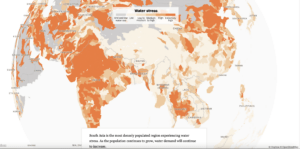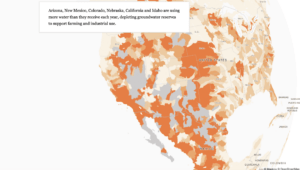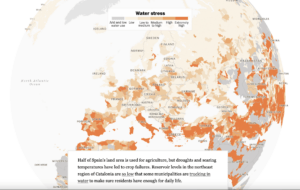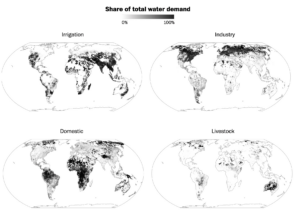BLOG
August 16th, 2023
Courtesy of The Washington Post, a report on where water is running out in the world – and why:
A growing population and rising temperatures will strain the world’s freshwater supplies over the next 30 years, jeopardizing available water for drinking, bathing and growing food, according to new research.
An analysis of newly released data from the World Resources Institute (WRI) shows that by 2050 an additional billion people will be living in arid areas and regions with high water stress, where at least 40 percent of the renewable water supply is consumed each year. Two-fifths of the world’s population — 3.3 billion people in total — currently live in such areas.
WRIused a global hydrological model to estimate how renewable water sources — such as rivers and lakes, which are replenished through precipitation — might change under future climate change scenarios. According to their analysis, the Middle East and North Africa regions have the highest level of water stress in the world. Climate change is shifting traditional precipitation patterns, making the regions drierand reducing their already scarce water supplies. Population growth and industrial use of water are expected to increase demand.
Here are a few areas experiencing water scarcity around the world.
South Asia is the most densely populated region experiencing water stress. As the population continues to grow, water demand will continue to increase.
Half of Spain’s land area is used for agriculture, but droughts and searing temperatures have led to crop failures. Reservoir levels in the northeast region ofCatalonia are so low that some municipalities are trucking in water to make sure residents have enough for daily life.
Arizona, New Mexico, Colorado, Nebraska, California and Idaho are using more water than they receive each year, depleting groundwater reserves to support farming and industrial use.
With climate change, “water challenges are only going to become more frequent and more intense,” said Heather Cooley, director of research for the Pacific Institute. “That needs to motivate us to begin preparing and implementing projects.”
The WRI analysis accounts for surface water, but not groundwater stores that are tapped when lakes, rivers and reservoirs run dry. This means the new estimates may underestimate risk. Many rural areas use groundwater for drinking water and farmers worldwide rely on it for irrigation. But groundwater often replenishes much more slowly than surface water.
“We’re not identifying when that groundwater is at risk of running out,” said Samantha Kuzma, the Aqueduct data lead at the World Resources Institute. Countries might be adapting to scarce surface water by tapping underground reserves, but “it doesn’t mean they’ll be able to adapt in the future.”
Only half of 1 percent of the world’s water supply is fresh water in liquid form. The rest is saltwater or frozen into glaciers.
Water is used to manufacture goods, extract minerals and produce energy, but its biggest use, globally, is for food production.
Agriculture accounts for 70 percent of water use each year, and is deeply affected by changes in precipitation.Even if a region is getting the same average amount of rain and snow, droughts and floodshave become more common. Rain may not arrivefor some time— then arrive all at once — instead of falling more evenly across a growing season. That makes it difficult for farmers to rely on rainfall to water crops and increases the need for water storage and irrigation.
“Just looking at the averages doesn’t tell the whole story,” said Matthew Rodell, thedeputy director of Earth Sciences at NASA’s Goddard Space Flight Center. “It’s much more useful and easier to live with if the water all comes regularly and without these extremes. But more and more, that’s not the case.”
Drought-prone but wealthy areas are generally able to manage water stress. A complicated series of agreements governs the water use in the Colorado River Basin,wherewater is stored and managed through dams and reservoirs. Even during droughts, residents in major cities in the Southwest have reliable tap water.
If surface water is in short supply, people often turn to groundwater, which can be rapidly depleted. In India, nearly 60 percent of the population makes a living from farming. For decades, the government supported farmers by subsidizing the cost of diesel to run water pumps and tractors and by purchasing wheat and rice at an artificially high price. Water demand to irrigate rice and wheat fields is contributing to groundwater depletion in the northern region of Punjab.
“There’s nothing to connect the actual scarcity of water to the farmers’ use of water,” said Charles Iceland, the director of Freshwater Initiatives with WRI’s Food, Land, and Water Program.
“More people demand more water, but also each person demands more water as they get wealthier,” Iceland said. “So as you get wealthier, you move from a more grain and vegetable-oriented diet to a more meat-oriented diet.”
Growing and feeding a cow to create one pound of beef requires as much as 1,800 gallons of water, by some estimates. Calorie-for-calorie, that’s almost eight times as much water as vegetables and 20 times as much water as cereals like wheat and corn.
Water-intensive crops like sugar cane and cotton could also drive demand in sub-Saharan Africa,where water use is expected to double over the next 20 years. Many areas still lack infrastructure to reliably deliver water for irrigation. As those pipelines are built, more farmers will have access to water, which will further strain surface water supplies. Inefficient water use and unsustainable management could lower gross domestic product in the region by 6 percent, according to WRI.
Where we farm is also a factor. “In some cases, we make ridiculous decisions in terms of where we grow crops,” Rodell said. One Saudi company is growing alfalfa in the Arizona desert, pulling from the area’s groundwater supplies. That alfalfa is then shipped overseas to feed cattle in Saudi Arabia, where industrial-scale farming of forage crops has been banned to conserve the nation’s water.
Water is also integral to mining lithium and other minerals used in electric vehicle batteries and renewable energy infrastructure. These critical minerals are often found in arid places like Chile, which is already water-stressed and is projected to use 20 percent more water by 2050, according to WRI.
Water use per capita in the most water-stressed countries
How we can limit water scarcity“There are lots of things we can do and need to do,” Cooley said.
Since farming accounts for the most water use globally, experts say that micro-sprinklers and drip irrigation instead of flood irrigation are an important solution.
A price on water would also encourage efficiency. It’s important for the poorest people to have enough water to drink and use in their households, says Iceland, “but above those humanitarian amounts, you have to really price water in a way that will make sure that it’s used in the most economical ways possible.”
Cities can develop infrastructure to capture and reuse stormwater runoff, repair leaks in municipal water systems and encourage water efficiency. In Nevada, the Las Vegas Valley Water District created a grass replacement program and fined water waste, which reduced the area’s total water use by 26 billion gallons per year from 2002 to 2021, even as the area’s population grew by 750,000 residents. Nationwide, more efficient appliances have reduced per-capita household water use since 1980.
Food choices can have a big impact, too. Raising livestock for meat and dairy takes much more water than growing vegetables and grains, so reducing meat and dairy consumptioncan decrease individual water footprints. Reducing food waste could also help reduce water use. In the United States, more than a third of food ends up in the landfill. The biggest single contributor to food wasteis throwing away food at home.
“People need to recognize and understand the importance of water,” Cooley said. In many places, people can turn on a tap and water is just there, she said, so “we’ve taken it for granted. We’ve undervalued it. And that has to change.”









